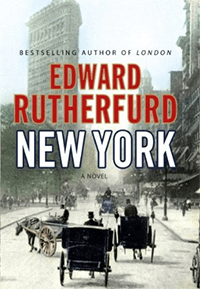New York (novel) facts for kids

New York first (UK) edition cover.
|
|
| Author | Edward Rutherfurd |
|---|---|
| Illustrator | Mike Morganfeld (maps) |
| Country | United Kingdom |
| Language | English |
| Genre | Historical novel |
| Publisher | Century Hutchinson, Doubleday (US) |
|
Publication date
|
3 September 2009 |
| Media type | Print (Hardback & Paperback) |
| Pages | 1040 pp (first edition) (862 pp US first ed.) |
| ISBN | 978-1-84605-195-1 |
| OCLC | 613432261 |
New York: a Novel is an exciting historical novel written by British author Edward Rutherfurd. It was first published in 2009. In the United States, it's known as New York: The Novel.
Discovering New York's Story
This book tells the amazing story of New York City. It shows how the city was born and grew over many centuries. The tale begins with the first Dutch and other European settlers in the 1600s. It continues all the way up to the summer of 2009.
How New York Grew
Edward Rutherfurd builds his story around fictional families. These families live in New York City through different time periods. They represent the many groups of people who came to the city. These immigrants helped make New York the diverse place it is today.
Meet the Families
The novel starts with the early Dutch settlers of New Amsterdam. The Van Dyck family is a good example of these first founders. They became successful by trading with the Native American tribes. These included the local Algonquian people, like the Lenape, and the Mohawk who lived further north.
Later, the Van Dycks connect with the English Thomas Master family. Thomas Master also had a Native American daughter. Descendants of the Van Dyck-Master families live in New York throughout the whole book. They help connect the many stories.
The character Quash was an African person brought to New Amsterdam against his will. He was held by Thomas Master. His descendants also become an important part of New York's culture.
As the city grows, more families are introduced. These include the Irish O'Donnels and German Kellers. You'll also meet the Italian Carusos, German-Jewish Adlers, and Puerto Rican Campos. Through their linked stories, Rutherfurd explores different cultural traditions. He shows how these groups interacted as the city developed.
Following the Timeline
Rutherfurd divides the book into twenty-seven sections by date. Most dates cover one chapter. A few dates might continue through two or three chapters. The book includes three helpful maps of Manhattan Island. These maps let readers follow the city's changes as the story unfolds. A fourth map shows the larger New York City area.

